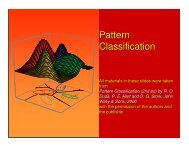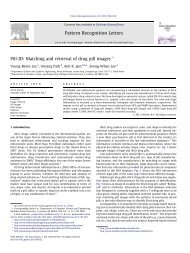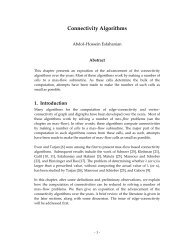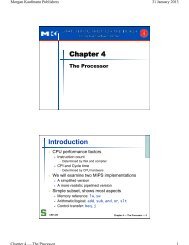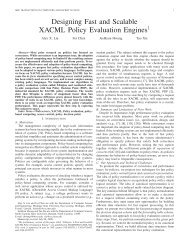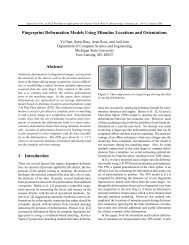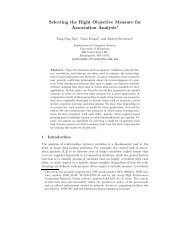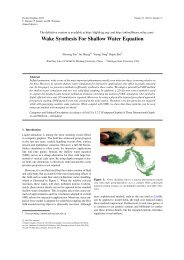portion of the database can be filtered out by using the subject’sdemographic information (e.g. gender, ethnicity, agerange, date of birth). In the latent case, this information isusually not available because the latent comes from an unknownsubject. In addition, there is a huge gap betweenthe matching performance of rolled-to-rolled matching <strong>and</strong>latent-to-rolled matching due to the partial <strong>and</strong> noisy natureof the latents; this makes the latent matching problem —<strong>and</strong> thus the latent indexing problem — much more challengingthan the rolled print matching problem.<strong>Fingerprint</strong> friction ridge features are generally describedat three different levels: level 1 features such as orientationfield, singular points <strong>and</strong> type, level 2 features suchas minutiae <strong>and</strong> level 3 features such as pores <strong>and</strong> ridge contours.Unlike rolled or plain fingerprint, level 1 or level 2features alone are usually not sufficient for latent indexingdue to partial ridge information <strong>and</strong> complex backgroundnoise. Thus fusion of level 1 <strong>and</strong> level 2 features in latentindexing is essential.In this paper, we propose to use a fusion of level 1<strong>and</strong> level 2 features to improve the indexing performance.Firstly, orientation field in the neighborhood of each minutiais encoded into a rotation- <strong>and</strong> translation-invariant fixedlength bit vector. The bit vectors are then indexed by meansof Locality-Sensitive Hashing (LSH) [8]. Then, conventionalminutiae triplet based indexing [7] is boosted by incorporatingrotation constraints. Orientation field indexing<strong>and</strong> triplet indexing are fused with fingerprint indexing techniquebased on the Minutia Cylinder-Code (MCC) representation[5], <strong>and</strong> this fusion is further boosted by combiningsingular points <strong>and</strong> ridge period filtering.2. Related Work<strong>Fingerprint</strong> indexing techniques can be roughly categorizedinto three classes based on the types of featuresused: minutiae-based, orientation field-based <strong>and</strong> techniquesbased on other features (see Table 1).Among the published works on indexing, only two ofthem reported the indexing performance on latent fingerprints.Feng <strong>and</strong> Jain [6] proposed a multi-stage filteringscheme whose first stage depends on the fingerprint patterntype, followed by the use of singular points <strong>and</strong> orientationfield. The features are manually marked for the latents,<strong>and</strong> automatically extracted in the rolled prints. Feng <strong>and</strong>Jain [6] reported the indexing performance on NIST SD 27against a relatively small background of 10,258 rolled printswhich is 97.3% hit rate at a 39% penetration rate. Thismeans that the true mates of 2.7% of the latents (among the258 latents in NIST SD 27) were not present in the filtereddatabase (39% of the 10,258 rolled prints).Yuan et al. [21] improved the performance of triplet indexingtechnique by using triplets to count the number ofpolygons of various sides. Like [6], they also used manuallymarked minutiae in the latents <strong>and</strong> automatically extractedminutiae in the rolled prints. Yuan et al. reported an accuracyof 92.7% hit rate at a 40% penetration rate (80.7% at10% penetration rate) for the NIST SD27 database againsta large background database of 240,258 rolled prints.3. Feature ExtractionIn this section we describe various features that are extractedfrom reference prints <strong>and</strong> latents. More specifically,the following features are extracted: minutiae, orientationfield, singular points <strong>and</strong> ridge period.3.1. Reference PrintsFor reference (rolled) prints in the background database,two commercial off-the-shelf (COTS) matchers are used toautomatically extract all the features. Based on our experiencewith these two matchers, one of the COTS matcher isused to extract minutiae <strong>and</strong> the other one is used to extractskeleton images. The orientation field <strong>and</strong> ridge period ofa reference print are extracted from the skeleton image asfollows: (i) morphological operations (dilation <strong>and</strong> erosion)are applied to the skeleton image to get a region of interest(ROI) of the reference print; (ii) the skeleton image is filteredwith an averaging filter of size 5 × 5 pixels to converta binary skeleton image to a grayscale image; (iii) the gradientbased algorithm proposed in [1] is used to extract orientationfield from the ROI region of the grayscale image; <strong>and</strong>(iv) the X-signature proposed in [9] is used to estimate theridge period from the ROI region of the grayscale image.From the orientation field, a list of singular points is extracted,if present, by the complex filter approach proposedin [16]. For both core <strong>and</strong> delta points, their directions canalso be extracted.3.2. <strong>Latent</strong>sFeature extraction in latents is a challenging problem dueto heavy background noise. Since the objective of our studyis indexing, we assume, similar to the studies in [6] <strong>and</strong>[21], that minutiae features have been marked in the latentsby examiners. This is the case for the NIST SD27 database.The orientation field <strong>and</strong> ridge period information in latentswere marked by the authors in [11] <strong>and</strong> are available to us.4. <strong>Indexing</strong> ApproachWe propose to combine different features <strong>and</strong> techniquesto improve latent fingerprint indexing performance. Ourapproach consists of combining a constrained version oftriplet indexing, MCC indexing as proposed in [5], a neworientation field descriptor indexing technique that useshash function, filtering based on singular points as proposedin [6], <strong>and</strong> averaged ridge period comparison. Basic triplet
RolledPlain<strong>Latent</strong>Liang et al. [13] Minutiae Triplets 550 queries <strong>and</strong> 330 templates (FVC2004 DB1 ∗ ) 99%Wang et al. [20] OF <strong>Fingerprint</strong> Orientation Queries <strong>and</strong> templates not indicated ( FVC2002 99.9%Model based on 2D DB1a)Fourier ExpansionShuai et al. [18] SIFT 500 queries <strong>and</strong> 300 templates (FVC2000 DB2a ∗ ) 98%Cappelli et al. [5] Minutiae MCC 700 queries <strong>and</strong> 100 templates (FVC2002 DB1a) 99%Iloanusi et al. [10] Minutiae Quadruplets 400 queries 400 templates (FVC2004 DB1a ∗ ) 98%Cappelli [3] OF + RF 500 queries <strong>and</strong> 300 templates (FVC2002 DB1a ∗ ) 99.9%Cappelli [4] Minutiae + OF MCC 700 queries <strong>and</strong> 100 templates (FVC2002 DB1a) 100%Liu <strong>and</strong> Yap [14] OF Polar Complex Moments 700 queries <strong>and</strong> 100 templates (FVC2002 DB1a) 85%Table 1. Summary of studies on fingerprint indexing for rolled, plain <strong>and</strong> latent prints.Author(s) <strong>Fingerprint</strong>FeaturesApproach <strong>Fingerprint</strong> Database HR @ PR =10%Bhanu <strong>and</strong> Tan [2] Minutiae Triplets 2,000 queries <strong>and</strong> 2,000 templates (NIST SD4) 85.5%Jiang et al. [12] OF + RF OF Clustering 2,000 queries <strong>and</strong> 2,000 templates (NIST SD4) 89.5%Wang et al. [20] OF <strong>Fingerprint</strong> Orientation 2,700 queries <strong>and</strong> 2,700 templates (last 2,700 pairs 98%Model based on 2D of NIST SD14)Fourier ExpansionCappelli et al. [5] Minutiae MCC 2,700 queries <strong>and</strong> 24,000 templates (NIST SD14) 95%Cappelli [3] OF + RF 1,000 queries <strong>and</strong> 1,000,000 templates (generated 99.6%by SFinGe v4.1)Cappelli [4] Minutiae + OF MCC 2,700 queries <strong>and</strong> 2,700 templates (last 2,700 pairs 98.7%of NIST SD14)Liu <strong>and</strong> Yap [14] OF Polar Complex Moments 2,000 queries <strong>and</strong> 2,000 templates (NIST SD4) 88%Bhanu <strong>and</strong> Tan [2] Minutiae Triplets 400 queries <strong>and</strong> 600 templates (collected by FIU- 100%500-F01 sensor)Jiang et al. [12] OF + RF OF Clustering 600 queries <strong>and</strong> 200 templates (FVC2000 DB2a & 92.5%DB3a)Feng <strong>and</strong> Jain [6] <strong>Fingerprint</strong>Type + SP + OFMulti-stage filtering 258 latent queries <strong>and</strong> 10,258 templates (NISTSD27 <strong>and</strong> NIST SD14)Yuan et al. [21] Minutiae Triplets 258 latent queries <strong>and</strong> 240,258 templates (NISTSD27 <strong>and</strong> a private database)Proposed ApproachMinutiae + OF Triplets + MCC + OF 258 latent queries <strong>and</strong> 267,258 templates (NIST+SP+RF Descriptor <strong>Indexing</strong> SD27, NIST SD14 <strong>and</strong>MSP)97.3% @PR=39% ∗∗80.7% ∗∗∗81.8% (95.7%@ PR=39%)OF: orientation field, SP: singular points, SIFT: scale invariant feature transform, MCC: minutia cylinder code, RF: ridge frequency, HR: hit rate, PR:penetration rate.*The images used as templates were r<strong>and</strong>omly selected from each finger.**Feng <strong>and</strong> Jain [6] only reported the hit rate at a single penetration rate of 39%.***The hit rate of algorithm in [21] evaluated on the database used in this paper is 58.1% @ PR=10%.indexing technique is improved by applying a rotation constraintto the matched triplets. Orientation field descriptorindexing is carried out first by converting the descriptor toa binary vector, followed by a hash function, similar to theapproach proposed in [5]. The indexing score based on eachone of these specific features is combined to obtain the finalindexing score. A description of the techniques used inour approach is presented below, <strong>and</strong> the overall scheme isshown in Fig. 2.4.1. Constrained Triplets <strong>Indexing</strong>Features extracted from the triangles (triplets) formed byminutia points have been popular for fingerprint matching<strong>and</strong> indexing [7, 2, 13, 21]. The basic features in [7] consistof the length of the sides of the triangles, the ridge countbetween every pair of minutiae in the triplet, <strong>and</strong> the anglebetween minutiae direction <strong>and</strong> the side of the triangle. Theordering of the sides of the triangle was defined in a clockwisedirection.In our approach, we use the three sides of the triangle,P 1 1 maxL minL medxRight h<strong>and</strong>ed med min3L 2maxP 3P 2Figure 3. Illustration of minutiae triplets features.<strong>and</strong> the difference between minutiae direction <strong>and</strong> one sideof the triangle for indexing. Ridge count between minutiaein latents is not sufficiently reliable, so we did not use it. Asproposed in [2], we order the sides as L max ,L min ,L med(see Fig. 3) <strong>and</strong> each minutia is associated with a vertex ofthe triangle. After the ordering of the sides <strong>and</strong> minutiae,the directional differences (θ i ,i = 1, 2, 3) between eachminutiae <strong>and</strong> one side of the triangle can be consistentlyobtained. We also use the h<strong>and</strong>edness φ ∈{−1, 1} of thetriangle proposed in [2] as a triplet feature.zy




